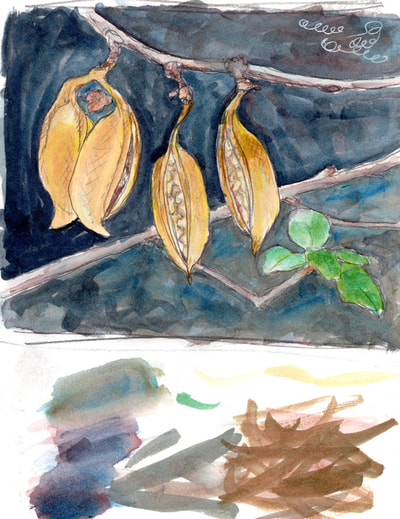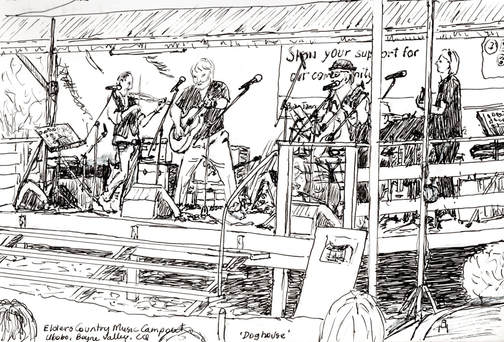|
I have drawn all sorts of things since I could hold a pencil. However, for most of my adult life my small sketches and drawings were merely preliminary, testing grounds for planning a new painting or more detailed drawing. On rare occasions I would do a series of on-site sketches to get the feel of a place. Preliminary sketches for paintings. The boat was done on-site using only pen. When we decided to travel around Australia I realised that I would need to keep my art supplies to a minimum so I chose to focus on drawing. All I needed was some basic drawing equipment - paper, pencils, eraser, pens, coloured pencils (I chose watercolour pencils for versatility), a mini watercolour set, a few brushes, a little container for water and some kitchen paper. My camera and iPad came in handy when I decided that on-site drawing in hordes of flies and intense heat wasn't for me. After awhile, these were the only materials I was using for my sketches - plus a white gel pen. Before leaving, I spent some time going out with friends to draw scenes around Gladstone, CQ. I needed to get back into the swing of things, refreshing my drawing skills and boosting my confidence in making quick sketches. A4 practice drawings - Toondoon Botanic Gardens, Gladstone, CQ. Drawn on-site with finishing touches added in my studio. Generally, I start with a rough pencil sketch using a 2B automatic pencil (no need to sharpen - just have refills on hand). I tinker with the sketch until I am satisfied that it is an honest representation of the scene - not necessarily perfectly accurate but enough that it looks right to me. There are no creative adjustments to the scene (ie no artistic licence) as my aim is to capture the actual scene, as I see it. I don't 'shift' or 'remove' things that disturb the scene (eg awkwardly positioned poles) other than vehicles that park in the way and block my subject matter. Creative adjustments can occur later when making finished paintings. Once I am satisfied with the sketch, I mark in the details including shading with pen. My favourite pen is a 0.1 uni pin, fine line, black, waterproof, pigment ink pen. I try to develop a greater degree of accuracy and neatness (not always successful - but, hey, it is only a simple sketch). If any lines get a bit wayward (shaky hands) or misplaced (messy, confusing, pencil sketch) a white gel pen comes to the rescue as a cover up. The pencil marks are erased, then I leave the sketch for awhile (have a cuppa) and when I come back to it I see it with fresh eyes and possibly (usually) make some adjustments - generally to the shading. Then it is time for the watercolour. I use a mini Windsor and Newton, watercolour palette that has been a part of my life since 1979 but I am not a watercolourist so it has not had much use. I have only recently added some tube ultramarine to replenish the pan and I also use a tube of cerulean blue - my preference for Australian skies. My paintbrush is a no 16, Art Spectrum, 1300, white taklon which I have found to be a good, general purpose brush - suitable for washes on A5 and can also handle fine detail. I do carry a couple of smaller brushes but never use them. Again, the white gel pen comes in handy for re-establishing lost whites (yes, I am a bit messy with the colour) and adding fine lines or marks. I found that A5 visual diary paper is a bit fragile if overworked with watercolour. It really needs a delicate touch - something alien to me. Needless to say, a few of my drawings have ended up with holes in the paper - thankfully not obvious.
Anyone, who is interested in recording their day to day environment via sketches, should just jump in and get started. It doesn't matter the level of expertise - that comes with practise. There is no right or wrong way to approach sketching. All you need to do is make marks on something (anything - doesn't have to be new paper). The marks can be with any media that makes marks. It is up to you to build your marks, in any way that you want, to get to an end result. Certainly, look at what others do, pick out what is useful to you and then do it your way. Over time, you will develop a preferred way of working and your skills will improve. It just takes practise - lots of it. Now, go grab some gear and get started. Until next time, Anne Comments are closed.
|
Anne HuthI have had a lifetime passion for drawing and painting. Realistic with an impressionistic touch is an apt description for my work. Archives
August 2019
Previous Blogs
14/10/2018
Diary of a tired artist continued 3/7/2018
Blogging and other distractions! 02/06/2018
Who or what is your muse? 27/05/2018
Burntout? Lost the plot? Gripped by mental fatigue? 20/05/2018 Do you market your artwork online? 13/05/2018 Working towards my first workshop presentation. 03/05/2018 Do you want to draw but don't have any art materials? 28/04/2018 Drawing from photos versus drawing on location. 21/04/2018 Something different - Games of War - a project addressing war games & PTSD. 17/04/2018 A bit more about my drawings. 08/04/2018 Write a blog they say! |









